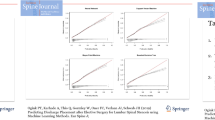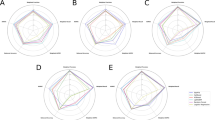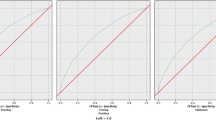Abstract
Purpose
We aimed to develop a machine learning algorithm that can accurately predict discharge placement in patients undergoing elective surgery for degenerative spondylolisthesis.
Methods
The National Surgical Quality Improvement Program (NSQIP) database was used to select patients that underwent surgical treatment for degenerative spondylolisthesis between 2009 and 2016. Our primary outcome measure was non-home discharge which was defined as any discharge not to home for which we grouped together all non-home discharge destinations including rehabilitation facility, skilled nursing facility, and unskilled nursing facility. We used Akaike information criterion to select the most appropriate model based on the outcomes of the stepwise backward logistic regression. Four machine learning algorithms were developed to predict discharge placement and were assessed by discrimination, calibration, and overall performance.
Results
Nine thousand three hundred and thirty-eight patients were included. Median age was 63 (interquartile range [IQR] 54–71), and 63% (n = 5,887) were female. The non-home discharge rate was 18.6%. Our models included age, sex, diabetes, elective surgery, BMI, procedure, number of levels, ASA class, preoperative white blood cell count, and preoperative creatinine. The Bayes point machine was considered the best model based on discrimination (AUC = 0.753), calibration (slope = 1.111; intercept = − 0.002), and overall model performance (Brier score = 0.132).
Conclusion
This study has shown that it is possible to create a predictive machine learning algorithm with both good accuracy and calibration to predict discharge placement. Using our methodology, this type of model can be developed for many other conditions and (elective) treatments.
Graphical abstract
These slides can be retrieved under Electronic Supplementary Material.



Similar content being viewed by others
References
International Federation of Health Plans (2015) Variation in Medical and Hospital Prices by Country. Comp Price Rep
Regenbogen SE, Cain-Nielsen AH, Norton EC et al (2017) Costs and consequences of early hospital discharge after major inpatient surgery in older adults. JAMA Surg 152:e170123. https://doi.org/10.1001/jamasurg.2017.0123
Basques BA, Tetreault MW, Della Valle CJ (2017) Same-day discharge compared with inpatient hospitalization following hip and knee arthroplasty. J Bone Joint Surg Am 99:1969–1977. https://doi.org/10.2106/JBJS.16.00739
Costa AP, Poss JW, Peirce T, Hirdes JP (2012) Acute care inpatients with long-term delayed discharge: evidence from a Canadian health region. BMC Health Serv Res 12:6–11. https://doi.org/10.1186/1472-6963-12-172
Watkins JR, Soto JR, Bankhead-Kendall B et al (2014) What’s the hold up? Factors contributing to delays in discharge of trauma patients after medical clearance. Am J Surg 208:969–973. https://doi.org/10.1016/j.amjsurg.2014.07.002
Hwabejire JO, Kaafarani HMA, Imam AM et al (2013) Excessively long hospital stays after trauma are not related to the severity of illness: let’s aim to the right target! JAMA Surg 148:956–961. https://doi.org/10.1001/jamasurg.2013.2148
Andrews LB, Stocking C, Krizek T et al (1997) An alternative strategy for studying adverse events in medical care. Lancet 349:309–313. https://doi.org/10.1016/S0140-6736(96)08268-2
Hauck K, Zhao X (2011) How dangerous is a day in hospital? Med Care 49:1068–1075. https://doi.org/10.1097/MLR.0b013e31822efb09
Gruskay JA, Fu M, Bohl DD et al (2015) Factors affecting length of stay after elective posterior lumbar spine surgery: a multivariate analysis. Spine J 15:1188–1195. https://doi.org/10.1016/j.spinee.2013.10.022
Sharma M, Sonig A, Ambekar S, Nanda A (2014) Discharge dispositions, complications, and costs of hospitalization in spinal cord tumor surgery: analysis of data from the United States Nationwide Inpatient Sample, 2003–2010. J Neurosurg Spine 20:125–141. https://doi.org/10.3171/2013.9.SPINE13274
Best MJ, Buller LT, Falakassa J, Vecchione D (2015) Risk factors for nonroutine discharge in patients undergoing spinal fusion for intervertebral disc disorders. Iowa Orthop J 35:147–155
Niedermeier S, Przybylowicz R, Virk SS et al (2017) Predictors of discharge to an inpatient rehabilitation facility after a single-level posterior spinal fusion procedure. Eur Spine J 26:771–776. https://doi.org/10.1007/s00586-016-4605-2
McGirt MJ, Parker SL, Chotai S et al (2017) Predictors of extended length of stay, discharge to inpatient rehab, and hospital readmission following elective lumbar spine surgery: introduction of the Carolina–Semmes Grading Scale. J Neurosurg Spine 27:382–390. https://doi.org/10.3171/2016.12.SPINE16928
Slover J, Mullaly K, Karia R et al (2017) The use of the Risk Assessment And Prediction Tool in surgical patients in a bundled payment program. Int J Surg 38:119–122. https://doi.org/10.1016/j.ijsu.2016.12.038
Kanaan SF, Yeh H-W, Waitman RL et al (2014) Predicting discharge placement and health care needs after lumbar spine laminectomy. J Allied Health 43:88–97
Jordan M, Mitchell T (2015) Machine learning: trends, perspectives, and prospects. Science 80(349):255–260
Senders JT, Staples PC, Karhade AV et al (2018) Machine learning and neurosurgical outcome prediction: a systematic review. World Neurosurg 109:476–486.e1. https://doi.org/10.1016/j.wneu.2017.09.149
Schoenfeld AJ, Le HV, Marjoua Y et al (2015) Assessing the utility of a clinical prediction score regarding 30-day morbidity and mortality following metastatic spinal surgery: the New England spinal metastasis score (NESMS). Spine J 16:482–490. https://doi.org/10.1016/j.spinee.2015.09.043
Bekelis K, Desai A, Bakhoum SF, Missios S (2014) A predictive model of complications after spine surgery: the national surgical quality improvement program (NSQIP) 2005–2010. Spine J 14:1247–1255. https://doi.org/10.1016/j.spinee.2013.08.009
Veeravagu A, Li A, Swinney C et al (2017) Predicting complication risk in spine surgery: a prospective analysis of a novel risk assessment tool. J Neurosurg Spine 27:81–91. https://doi.org/10.3171/2016.12.SPINE16969
Sebastian A, Huddleston P, Kakar S et al (2016) Risk factors for surgical site infection after posterior cervical spine surgery: an analysis of 5,441 patients from the ACS NSQIP 2005–2012. Spine J 16:504–509. https://doi.org/10.1016/j.spinee.2015.12.009
Steinberg SM, Popa MR, Michalek JA et al (2008) Comparison of risk adjustment methodologies in surgical quality improvement. Surgery 144:662–667. https://doi.org/10.1016/j.surg.2008.06.010 (discussion 662–667)
Davenport DL, Holsapple CW, Conigliaro J (2009) Assessing surgical quality using administrative and clinical data sets: a direct comparison of the university healthsystem consortium clinical database and the national surgical quality improvement program data set. Am J Med Qual 24:395–402. https://doi.org/10.1177/1062860609339936
Posada D, Buckley TR (2004) Model selection and model averaging in phylogenetics: advantages of akaike information criterion and bayesian approaches over likelihood ratio tests. Syst Biol 53:793–808. https://doi.org/10.1080/10635150490522304
Rolston JD, Han SJ, Chang EF (2017) Systemic inaccuracies in the national surgical quality improvement program database: implications for accuracy and validity for neurosurgery outcomes research. J Clin Neurosci 37:44–47. https://doi.org/10.1016/j.jocn.2016.10.045
Murphy ME, Maloney PR, McCutcheon BA et al (2017) Predictors of discharge to a nonhome facility in patients undergoing lumbar decompression without fusion for degenerative spine disease. Neurosurgery 81:638–649. https://doi.org/10.1093/neuros/nyx057
Abt NB, McCutcheon BA, Kerezoudis P et al (2017) Discharge to a rehabilitation facility is associated with decreased 30-day readmission in elective spinal surgery. J Clin Neurosci 36:37–42. https://doi.org/10.1016/j.jocn.2016.10.029
Kelly DM, Bennett R, Brown N et al (2012) Predicting the discharge status after liver transplantation at a single center: a new approach for a new era. Liver Transplant 18:796–802. https://doi.org/10.1002/lt.23434
Tong MZ, Pattakos G, He J et al (2015) Sequentially updated discharge model for optimizing hospital resource use and surgical patients’ satisfaction. Ann Thorac Surg 100:2174–2181. https://doi.org/10.1016/j.athoracsur.2015.05.090
Cook NR (2007) Use and misuse of the receiver operating characteristic curve in risk prediction. Circulation 115:928–935. https://doi.org/10.1161/CIRCULATIONAHA.106.672402
Benson RT, Drew JC, Galland RB (2006) A waiting list to go home: an analysis of delayed discharges from surgical beds. Ann R Coll Surg Engl 88:650–652. https://doi.org/10.1308/003588406X149246
Gaughan J, Gravelle H, Siciliani L (2015) Testing the bed-blocking hypothesis: does nursing and care home supply reduce delayed hospital discharges? Health Econ 24:32–44. https://doi.org/10.1002/hec.3150
Harris AHS (2017) Path from predictive analytics to improved patient outcomes. Ann Surg 265:461–463. https://doi.org/10.1097/SLA.0000000000002023
Parikh RB, Kakad M, Bates DW (2016) Integrating predictive analytics into high-value care. JAMA 315:651. https://doi.org/10.1001/jama.2015.19417
Acknowledgements
The American College of Surgeons National Surgical Quality Improvement Program and the hospitals participating in the ACS-NSQIP are the source of the data used herein; they have not verified and are not responsible for the statistical validity of the data analysis or the conclusions derived by the authors.
Author information
Authors and Affiliations
Corresponding author
Ethics declarations
Conflict of interest
All authors declare that they have no conflict of interest.
Additional information
Publisher's Note
Springer Nature remains neutral with regard to jurisdictional claims in published maps and institutional affiliations.
Electronic supplementary material
Below is the link to the electronic supplementary material.
Rights and permissions
About this article
Cite this article
Ogink, P.T., Karhade, A.V., Thio, Q.C.B.S. et al. Development of a machine learning algorithm predicting discharge placement after surgery for spondylolisthesis. Eur Spine J 28, 1775–1782 (2019). https://doi.org/10.1007/s00586-019-05936-z
Received:
Revised:
Accepted:
Published:
Issue Date:
DOI: https://doi.org/10.1007/s00586-019-05936-z




